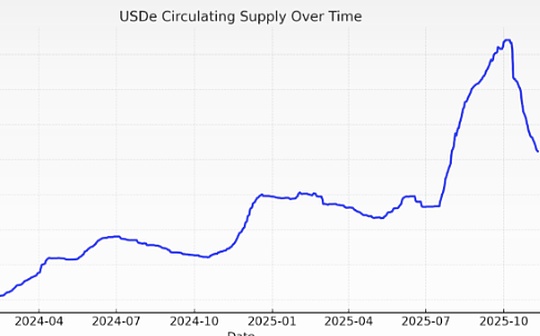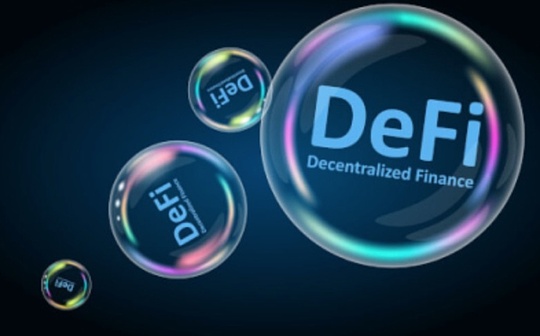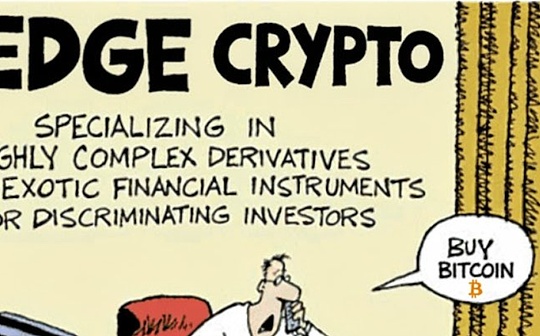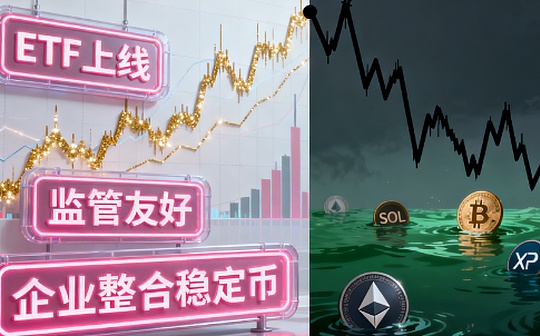
Within one month, the crypto market experienced two shocks on October 11 and November 03. Whether DeFi still has a future has become a common question for everyone. At this time, it is a good time to observe the current DeFi market structure and direction of change.
From the most macro perspective, DeFi is rapidly getting rid of the “second system effect”. The impact of stablecoins on traditional banks and payment industries is becoming increasingly real. The Federal Reserve’s attempt to provide streamlined moderator accounts is evidence of this. Institutional DeFi represented by Aave/Morpho/Anchorage is changing the operating model of traditional finance. Uniswap plans to turn on the fee switch and the Perp DEX War represented by Hyperliquid is still in full swing.
The characteristic of immaturity is to choose a noble death for your ideals. It is far from being said that DeFi has completely matured, and only the stage of large-scale adoption is left. In the sky of DeFi, there are still two dark clouds floating:
-
Who is the ultimate lender of the entire on-chain economic system? Morgan created the Federal Reserve. So what kind of mechanism should assume similar roles in DeFi?
-
In addition to the continuous matryoshka of established DEX/Lending/Stable products, how should truly original DeFi tracks or mechanisms be launched?
Price is the result of the game
Bart, as long as you’re online, I’m with you.
We are often deceived by omnipresence. In the small DeFi universe, all innovations so far have revolved around DEX/Lending/Stablecoin. This does not mean that BTC/ETH is not a mechanism innovation, nor does it mean that RWA/DAT/currency stocks/insurance are not asset innovation.
Referring to the six pillars of the on-chain protocol, BTC and Bitcoin essentially do not require any other assets or protocols. The DeFi we are talking about refers to projects that occur on public chains/L2 such as Ethereum/Solana. Referring to the leverage cycle of currency, stock and debt, the cost of selling innovative assets is getting higher and higher, and the entire industry is pursuing products with real profitability, such as Hyperliquid.
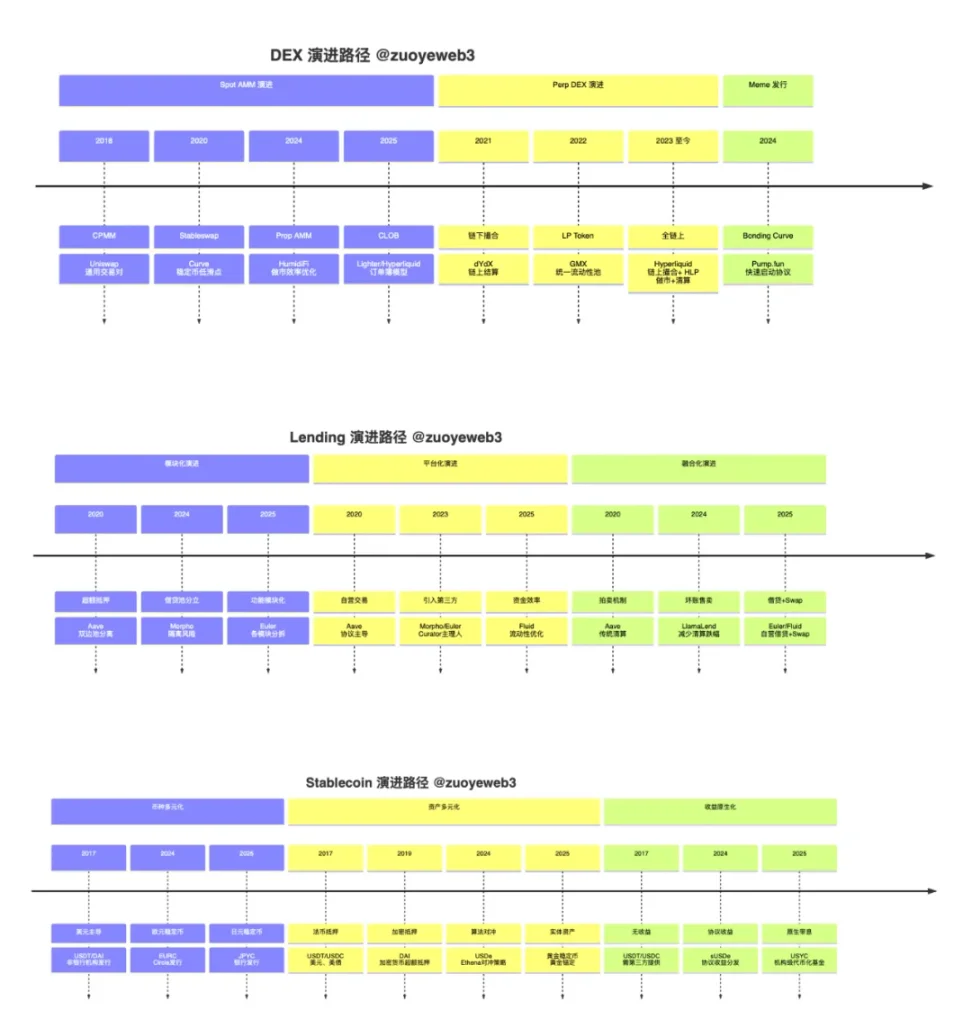
Picture description: DeFi paradigm evolution, picture source: @zuoyeweb3
Since the end of DeFi Summer, DeFi innovation has been the continuous improvement of established products, existing assets, and fait accompli. For example, transactions are divided into three types: spot, Perp, and Meme, which respectively correspond to AMM/CLOB/Bonding Curve during the DeFi Summer period. Even the most innovative Hyperliquid has many shadows of Serum hidden in it.
From the most microscopic perspective, Pendle started from the earliest fixed-income products and experienced the embrace of income-based stablecoins such as LST/LRT to Ethena. Euler and Fluid also chose to build their own lending + Swap products. If users use YBS such as Ethena to set up income strategies, they can theoretically realize any chain, any protocol, and any Vault while simultaneously utilizing DEX/Lending/Stablecoin.
While this synergistic effect amplifies profits, it also “creates” many liquidation tragedies and trust crises. Beyond this, there are No-Go Zones everywhere. Blockchain is born free, but it is shackles everywhere.
Decentralization is a beautiful vision, but centralization is more efficient. What is more impoverished than the track is the centralization of protocols. Aave is certainly large and safe, but it also means that you rarely have more and newer choices, while latecomers such as Morpho/Euler can only embrace unsafe managers and “inferior” assets.
Unbanked triggered the third world’s pursuit of stablecoins. It cannot be said that Aave’s prudence caused Morpho’s crisis, but unAaved also triggered the pursuit of secondary bonds, secondary protocols, and secondary managers by rats and mice on the chain and the younger generation.
Innovation can only occur among marginalized groups, and the cost of trial and error is too low. Those who survive will repeatedly impact the established pattern, and Aave V4 will become more like its own opponents rather than its own successful past.
The protocols and their tokens that we see now, their market prices, and transaction volumes are only intuitive reflections of the current environment. In other words, they are already recognized as the results of repeated games.
It is difficult to say whether it will be effective in the future or even have any reference significance. Stablecoin chains Plasma and Stablechain are extremely prosperous, but it is almost impossible to challenge the adoption rate of Tron and Ethereum. Even xUSD’s challenge to USDe, which is much smaller than USDT, has failed.
The pricing system favors time, and protocols that have lived longer tend to live longer. The success of Hyperliquid and USDe is the deviant outlier. How much market share Euler/Morpho/Fluid can seize Aave is worthy of discussion, but it is almost impossible to replace Aave.
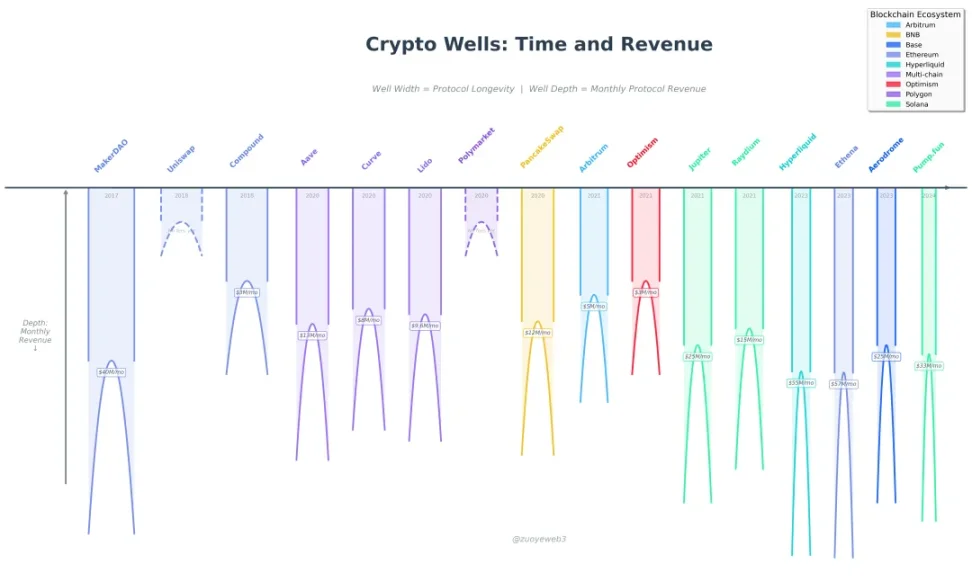
Image Caption: Crypto Gravity Wells: Timescales and Revenues, Image Source: @zuoyeweb3
Crypto Gravity Well: Time and App Rev [Continuous] From left to right is the coin issuance time, from top to bottom is Rev
-
Time: Balancer (stolen), Compound (silence), Aave (thrive) capture our time
-
Rev: The ability to make money is the only commercial value. One is the value of its own token BTC (USDT issuance, this is the shortcut for earning stablecoins), and the other is the ability to capture value (Pump’s mining and selling).
Competition is turning inward, and money is being burned in exchange for growth.
As shown in the figure above, the x-axis is the time that the agreement has continued to this day, and the y-axis is the value capture ability of the agreement. Compared with indicators such as token price, transaction volume, and TVL, the ability to make money is already the most objective representative (Polymarket theoretically does not make money).
Theoretically, the earlier a protocol is established, the stronger its stable profitability will be. If latecomers want to enter the game, they can only continuously enhance their own token<>liquidity<> trading volume flywheel. Refer to Monad/Berachain/Story. Failure is a higher probability.
value as goal in balance
Believe in the power of the masses, but do not believe in the wisdom of the masses.
DeFi is a movement, and relative to exchanges and TradFi, in the context of overall looseness, it is indeed one of the best innovation cycles in history, and perhaps a new paradigm beyond DeFi Summer will be born.
Exchanges are getting hammered, Hyperliquid’s transparency is showing more antifragility than Binance for the first time, after 1103, the pace of lending and stablecoins slows but is not falsified, people do need subordinated bonds, and simple fund/bond/equity certificates-stablecoins.
Compared with market makers who were restricted by CEX’s liquidity migration in 10·11, on-chain transactions, spot/contracts, and alternative assets are all actively expanding their scale. As long as the problem can be engineered and combined, there is the possibility of being completely solved.
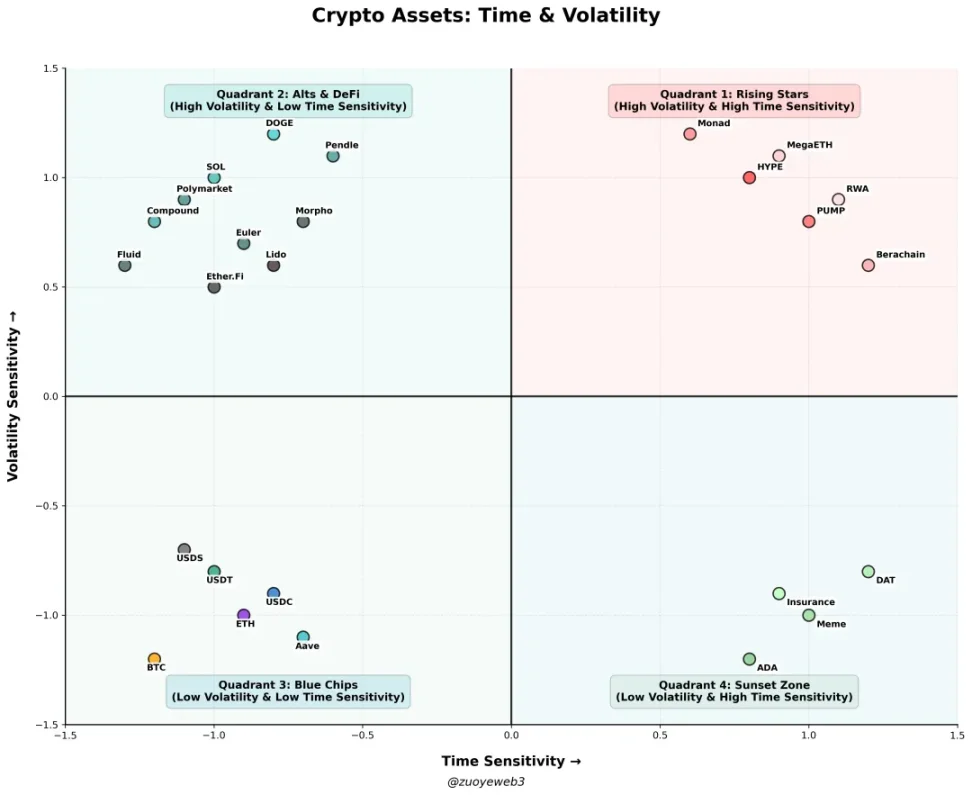
Image caption: Cryptoassets: Time & Volatility, Image source: @zuoyeweb3
-
The first quadrant (rookie area): HYPE, PUMP, public chain/L2/Alt L1 (Monad, Berachain, MegaETH), RWA (Bond, Gold, Real Estate)
-
The second quadrant (copycat area): DOGE, SOL, Compound, Pendle, Polymarket, Euler, Fluid, Morpho, Ether.Fi, Lido, No-USD Stablecoin, Option,
-
The third quadrant (industry leadership): BTC/ETH/USDT/USDC/USDS/Aave/
-
The fourth quadrant (death zone): ADA, Meme, DAT, Insurance
Put many new assets into the Rookie Zone. They are sensitive to time and volatility and are essentially short-term speculative assets. Only by transcending the simple game cycle and falling into stable currency holders and usage scenarios can they enter the Shanzhai Zone. That is, they are not particularly sensitive to time, but the liquidity cannot withstand violent market changes, and most projects will stay here.
Moreover, the harder the project team works, for example, under measures such as ve(3,3), buyback, destruction, merger, name change, etc., it may still stay here. It can be regarded as a gentle climbing period. If you do not make progress, you will retreat. If you work hard to move forward, you may go backwards.
The story after that is simple. The tribulation successfully entered the stable zone and became the so-called cycle-traveling assets, such as BTC and ETH. Perhaps half of SOL and USDT can be added, but most of the assets will slowly die. At this time, they are neither time sensitive nor volatile at all.
Meme and DAT will exist for a long time as a track, but it is difficult for the assets under it to have long-term opportunities, and the very few Meme and copycat representative assets such as DOGE and XRP are outliers.
In fact, if the protocol is regarded as asset innovation, many problems will be easily solved. That is, the purpose of starting a business is to sell itself once and for all, rather than pursuing the goal of becoming an ongoing open system:
-
Spot DEX: The transaction itself is concentrated on mainstream assets (BTC/ETH) and whale swap positions. Retail investors no longer trade altcoins. The core of the project is to seek specific customers, rather than becoming a public infrastructure without access. For example, dark pools rationalize the information gap between whales and retail investors;
-
Perp DEX: Lighter’s huge financing news is a prelude to the currency issuance, and VCs are highly differentiated. Big Name is more like TGE’s funding source, while small VCs can only die in the Perp track, and retail investors can only pick up garbage on various launchpads;
-
Meme: Sentiment itself has become a tradable asset and cannot become an industry-wide consensus. There is no sign of PumpFun’s ability or sign to solve this problem.
-
Platform & Modular Lending: A long-term trend, lending protocols can sell their own liquidity, brand and technology in pieces, which is essentially a B2B2C model
-
Integrated development of DEX+Lending: It is the latest batch among matryoshka dolls, and a special article will be published later to introduce its mechanism.
-
Non-U.S. dollar stablecoins/non-anchored U.S. dollar stablecoins: In the short term, the focus is on developed regions such as the euro, Japanese yen, and Korean won, but the long-term market can only be in the third world
Here is a separate list of the market conditions of income-based stablecoins. Generally speaking, income-based stablecoins are the most suitable asset form for serial DEX/Lending/Stable, but they will require a huge amount of engineering portfolio capabilities.
In contrast, there are innovative models other than DEX/Lending/Stable, and there are currently fewer observation samples. For example, the stable currency NeoBank is still a comprehensive model of the three, and the prediction market belongs to the generalized DEX type. The better ideas may be Agentics and Robotics.
The Internet has brought replicable scale expansion, which is very different from the production model of the industrial era, but there has been no corresponding economic model for a long time. Advertising economics needs to be at the expense of user experience. Compared with LLM on-chain, Agentics is at least more suitable for the technical characteristics of blockchain, that is, the all-weather transaction efficiency brought about by extreme programmability.
With gas fees getting cheaper, and years of TPS improvements and ZK building, large-scale adoption of blockchain is likely to happen in a replication economy that does not require human participation.
The combination of Robotics and cryptocurrency is not very interesting in the short term. At least until Yushu gets rid of the gimmicks and teaching aid value, it will be difficult for robots to really land in Web3. Only God knows what will happen in the long term.
Conclusion
Make DeFi more DeFi.
Robotics has been around for too long, and liquidation is only a matter of time.
The compound liquidation mechanism of DEX+Lending is an active construction of the DeFi crisis. However, it could not stop the spread of the 11·03 crisis. The most effective thing was Aave’s early rejection. Looking at the entire industry, how to handle liquidation and restore the market has become the biggest industry problem.
In 2022, after the 3AC incident broke out, SBF took the initiative to acquire and reorganize the agreement involved. Then FTX was also taken over by a traditional law firm in less than half a year. After the explosion of Stream’s xUSD, it was also transferred to the law firm as soon as possible.
Code is Law, is about to become Lawyer is Coder.
Before SBF and law firms, BTC had long played the role of final liquidator. It just took a long time to rebuild people’s trust in the on-chain economy, but at least, we still have BTC.

